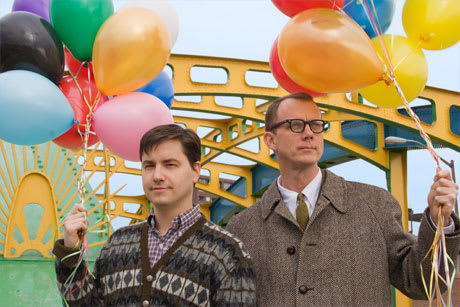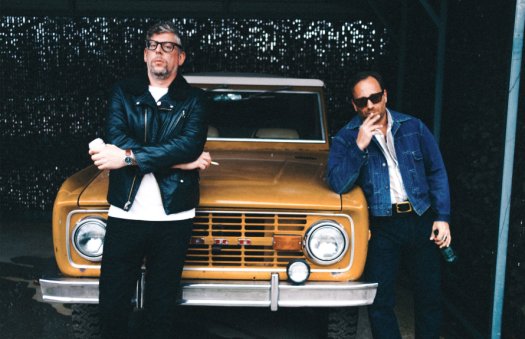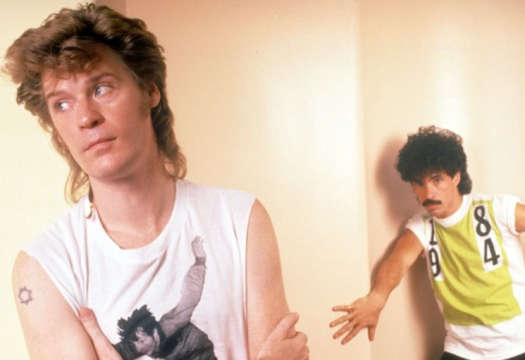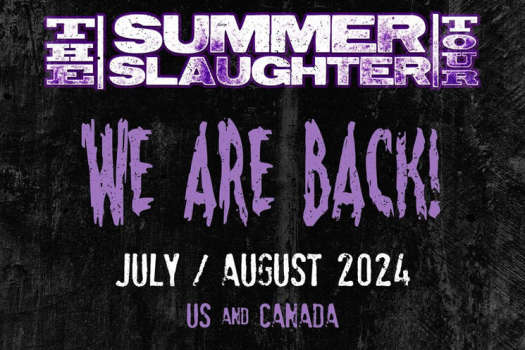Over the course of their 13 years as Matmos, M. C. Schmidt and Drew Daniel have essentially reinvented their sound with each new record. Often viewed as a novelty act for their radical thinking, the duo's concepts have dealt with everything from sound collages made of samples lifted from plastic surgery (A Chance to Cut Is a Chance to Cure), skin flicks (The Rose Has Teeth in the Mouth of a Beast) and "crustacean brain activity" (Matmos) to the English and American Civil Wars (The Civil War). Their unique approach to crafting their music has also led them to a high profile collaborative relationship with Björk, who invited them to sculpt sounds for her Vespertine and Medúlla albums. Their seventh album, Supreme Balloon finds the couple losing the gimmicky outside sources for an album that stresses "no microphones were used on this album," according to its liner notes. Made purely with vintage synthesizers, these "gear sluts" truly put their imaginations to the test, and come up with one of their finest albums yet, centred around the ridiculously epic title track. Daniel took some time out from their tour to answer some questions via email.
Your previous three albums had concepts behind them. What made you decide to take a break from the concept album theme with Supreme Balloon?
We take turns being responsible for albums. The Rose Has Teeth was my baby, so it was Martin's turn, and he felt that something of a backlash was in order. Plus, he's really good at programming and playing synthesizers, so maybe he just wanted to show off a bit.
What brought on the interest in using only synthesizers, and wait a minute, is this not some kind of concept?
Technically, the only "concept" was the restriction of "no microphones," and that rather tidily led to synthesizers and computer-generated audio from fancy software programs. But the risk was that it would produce a shrill and airless record, or an overly fussy one.
Was it difficult working with a synths-only restriction?
It was difficult stopping. We made so many songs for this album, and only used a fraction of them for the official CD version. We made a lot of heavy, gnarly ugly industrial-clanking tracks that got shelved, and we kept the pretty, celestial, floating ones.
Would you consider yourselves "gear heads"? Were there certain synths you sought out in order to make the album or experiment? Or did you use what you already owned?
I would consider us "gear sluts" in that we used everything we had and we shamelessly threw ourselves at all of our friends that we knew had cool rare synths, and we barged in on all sorts of people in hopes that they would help out. And they did.
Can you tell me what's involved in the Supreme Balloon performance? Are you guys manning an army of synths? How does this tour differ from previous ones?
One big change is that now we're a trio with Jay Lesser in the band, which we haven't done since the Vespertine tour with Bjork in 2001. So it's a nice reunion having Jay in the group because we can jam out the synth odysseys with him but we can also play songs from The West (from 1998, just re-issued). There are many many synths onstage and it makes us an expensive band at the airport, but hopefully the shows are worth it. We have tried to be as pure as we can be about recreating the core of the songs while still making it something that is visual. Martin's video work is crucial to that.
The title track is probably my favourite thing you've ever done. Can you tell me a little bit about how that song developed, what inspired it and how it became 24 glorious minutes long?
I am glad that it affected you; we knew that it was a big risk to stake a great deal of the album on one song, but it felt right for us to take this step. The tabla patterns seem to permit a kind of long, slowly unfolding musical shape, they put you into a receptive state of mind and allow things to proceed in an unhurried manner. The song started with the layering of "taals" (Indian classical rhythmic patterns) and then we synched up every sequencer in our house and let them build and interact naturally over some simple themes that have the same notes but different loop lengths- a basic minimalist compositional idea. The song was improvised and then extensively edited and thinned and thickened in various places to draw out the contours - but the basic narrative was improvised. It's really fun to play live, but it's a funny one to do live because by the time it is over everyone is so relaxed that the audience is just spaced out - they don't yell and scream and applaud, they kind of float out of the concert hall. It's a mellow experience.
I'd like to point out that for a good eight seconds, from the 1:34 mark, "Exciter Lamp And The Variable Band" seems to use the melody from "Oh Canada." Coincidence?
The song does indeed contain some of "Oh Canada"; it's meant to be a gesture of gratitude to the National Film Board of Canada for funding Norman McLaren, since the song is basically a tribute to him and he would not have been able to make his work without the Canadian government's money. We wondered if people would notice or not, and we're glad they did. We like to sneak bits of familiar music into our music - there's a snippet of "Shortnin' Bread" hidden in a song on The Civil War and a bit of "Peter and the Wolf" on Quasi-Objects, so it's all part of the plan.
"Les Folies Francaises" sounds a bit like Wendy Carlos, who I feel doesn't get enough credit these days as an influence. Was she on your minds at all when you were recording it?
Certainly. We really love her music, and not just Switched on Bach, but her own compositions. Sonic Seasonings and Beauty in the Beast are fabulous and frequently played at our house.
The press release reads like this: "That's right, no household objects played in a percussive manner, no snails or blood or amplified semen, no acoustic instruments, no voices of famous people for five seconds, not even any half-way cheating with Vocoders, just synthesizers of all shapes, sizes, eras and nationalities being snipped, folded and reshuffled by an arsenal of samplers and computers into colourful sound-origami." Reading that, does it make you at all wonder if people consider you guys to be some kind of novelty act?
Sure, of course that is one way to treat what we do. To me, I don't have a problem with "novelty music" - I grew up in a household in which Spike Jones was regarded as a musical genius. That said, I would hope that our music can hold people's attention without that dimension and "Supreme Balloon" was in part created to test whether or not that is true. I've been encouraged that people have been willing to follow us even when we aren't spanking and shaving members of the audience onstage. There's no reason that necessarily we won't do that sort of thing again in the future.
What made you decide to give four extra tracks to fans who buy vinyl? Are you trying to influence how your record is purchased?
I wanted to reward people who went for the vinyl, because I feel that this album's aesthetic, and in particular the idea of a single long (i.e. "side-long" song), is a product of the vinyl era. It was also a way to solve the conflict between M. C.'s idea of how to sequence the album and my own. So it turns the double LP with a gatefold into a hell of a consolation prize.
Your previous three albums had concepts behind them. What made you decide to take a break from the concept album theme with Supreme Balloon?
We take turns being responsible for albums. The Rose Has Teeth was my baby, so it was Martin's turn, and he felt that something of a backlash was in order. Plus, he's really good at programming and playing synthesizers, so maybe he just wanted to show off a bit.
What brought on the interest in using only synthesizers, and wait a minute, is this not some kind of concept?
Technically, the only "concept" was the restriction of "no microphones," and that rather tidily led to synthesizers and computer-generated audio from fancy software programs. But the risk was that it would produce a shrill and airless record, or an overly fussy one.
Was it difficult working with a synths-only restriction?
It was difficult stopping. We made so many songs for this album, and only used a fraction of them for the official CD version. We made a lot of heavy, gnarly ugly industrial-clanking tracks that got shelved, and we kept the pretty, celestial, floating ones.
Would you consider yourselves "gear heads"? Were there certain synths you sought out in order to make the album or experiment? Or did you use what you already owned?
I would consider us "gear sluts" in that we used everything we had and we shamelessly threw ourselves at all of our friends that we knew had cool rare synths, and we barged in on all sorts of people in hopes that they would help out. And they did.
Can you tell me what's involved in the Supreme Balloon performance? Are you guys manning an army of synths? How does this tour differ from previous ones?
One big change is that now we're a trio with Jay Lesser in the band, which we haven't done since the Vespertine tour with Bjork in 2001. So it's a nice reunion having Jay in the group because we can jam out the synth odysseys with him but we can also play songs from The West (from 1998, just re-issued). There are many many synths onstage and it makes us an expensive band at the airport, but hopefully the shows are worth it. We have tried to be as pure as we can be about recreating the core of the songs while still making it something that is visual. Martin's video work is crucial to that.
The title track is probably my favourite thing you've ever done. Can you tell me a little bit about how that song developed, what inspired it and how it became 24 glorious minutes long?
I am glad that it affected you; we knew that it was a big risk to stake a great deal of the album on one song, but it felt right for us to take this step. The tabla patterns seem to permit a kind of long, slowly unfolding musical shape, they put you into a receptive state of mind and allow things to proceed in an unhurried manner. The song started with the layering of "taals" (Indian classical rhythmic patterns) and then we synched up every sequencer in our house and let them build and interact naturally over some simple themes that have the same notes but different loop lengths- a basic minimalist compositional idea. The song was improvised and then extensively edited and thinned and thickened in various places to draw out the contours - but the basic narrative was improvised. It's really fun to play live, but it's a funny one to do live because by the time it is over everyone is so relaxed that the audience is just spaced out - they don't yell and scream and applaud, they kind of float out of the concert hall. It's a mellow experience.
I'd like to point out that for a good eight seconds, from the 1:34 mark, "Exciter Lamp And The Variable Band" seems to use the melody from "Oh Canada." Coincidence?
The song does indeed contain some of "Oh Canada"; it's meant to be a gesture of gratitude to the National Film Board of Canada for funding Norman McLaren, since the song is basically a tribute to him and he would not have been able to make his work without the Canadian government's money. We wondered if people would notice or not, and we're glad they did. We like to sneak bits of familiar music into our music - there's a snippet of "Shortnin' Bread" hidden in a song on The Civil War and a bit of "Peter and the Wolf" on Quasi-Objects, so it's all part of the plan.
"Les Folies Francaises" sounds a bit like Wendy Carlos, who I feel doesn't get enough credit these days as an influence. Was she on your minds at all when you were recording it?
Certainly. We really love her music, and not just Switched on Bach, but her own compositions. Sonic Seasonings and Beauty in the Beast are fabulous and frequently played at our house.
The press release reads like this: "That's right, no household objects played in a percussive manner, no snails or blood or amplified semen, no acoustic instruments, no voices of famous people for five seconds, not even any half-way cheating with Vocoders, just synthesizers of all shapes, sizes, eras and nationalities being snipped, folded and reshuffled by an arsenal of samplers and computers into colourful sound-origami." Reading that, does it make you at all wonder if people consider you guys to be some kind of novelty act?
Sure, of course that is one way to treat what we do. To me, I don't have a problem with "novelty music" - I grew up in a household in which Spike Jones was regarded as a musical genius. That said, I would hope that our music can hold people's attention without that dimension and "Supreme Balloon" was in part created to test whether or not that is true. I've been encouraged that people have been willing to follow us even when we aren't spanking and shaving members of the audience onstage. There's no reason that necessarily we won't do that sort of thing again in the future.
What made you decide to give four extra tracks to fans who buy vinyl? Are you trying to influence how your record is purchased?
I wanted to reward people who went for the vinyl, because I feel that this album's aesthetic, and in particular the idea of a single long (i.e. "side-long" song), is a product of the vinyl era. It was also a way to solve the conflict between M. C.'s idea of how to sequence the album and my own. So it turns the double LP with a gatefold into a hell of a consolation prize.




